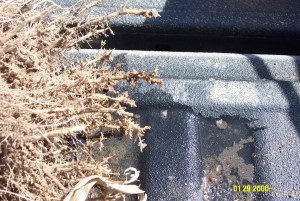 [1]Soils contain measurable quantities of aluminum. When the pH of the soil decreases below 5.3, the aluminum is released from within the clay layers and becomes a much more prominent mineral on the soil exchange sites and in soil solutions. Aluminum at high levels (usually > 20 ppm) is toxic to many plants and will affect plant growth. Aluminum causes morphological damage to plant parts. It affects photosynthesis by lowering chlorophyll content and reducing electron flow. Reduced respiratory activity might be due to reduced metabolic energy requirement. Protein synthesis is decreased. Aluminum interferes with the uptake, transport and use of several essential elements, including Cu, Zn, Ca, Mg, Mn, K, P and Fe.
[1]Soils contain measurable quantities of aluminum. When the pH of the soil decreases below 5.3, the aluminum is released from within the clay layers and becomes a much more prominent mineral on the soil exchange sites and in soil solutions. Aluminum at high levels (usually > 20 ppm) is toxic to many plants and will affect plant growth. Aluminum causes morphological damage to plant parts. It affects photosynthesis by lowering chlorophyll content and reducing electron flow. Reduced respiratory activity might be due to reduced metabolic energy requirement. Protein synthesis is decreased. Aluminum interferes with the uptake, transport and use of several essential elements, including Cu, Zn, Ca, Mg, Mn, K, P and Fe.
In corn, when aluminum levels increase above 20 ppm you begin to see root growth cease. The roots will be clubbed off and stunted as seen in the picture to the right. It will resemble other symptoms such as some nematodes or herbicide damage.
Below are some results from samples I took from a Nebraska field where aluminum toxicity was evident. Location 1 showed more stunting of the corn plants and more root symptoms than Location 2. Where pH was lower and aluminum levels were higher plant symptoms were more severe as would be expected.
| Location 1 | Location 2 | |||||||
| Soil depth | Soil pH | Aluminum, PPM | Soil depth | Soil pH | Aluminum, PPM | |||
| 0-3″ | 4.5 | 17 | 0-3″ | 5.9 | 4 | |||
| 3-8″ | 4.3 | 74 | 3-8″ | 5.2 | 32 | |||
| 8-18″ | 4.5 | 84 | 8-18″ | 5.1 | 52 | |||
If the pH is acidic in the top 3-4 inches it is easy to solve with an application of lime, however, when acidic soils are found below 6 inches it is more difficult to manage. Lime moves very little in the soil. One approach is to apply a heavy rate of lime (4 ton) and plow it under deep. This is often not preferred since erosion of these soils will be increased and lime still won’t move much. Frequently the soils with this condition are sandy soils.
Another way to manage these soils with acid subsoils is to apply gypsum and let it move through the soil profile. Gypsum is much more mobile than agricultural lime. The gypsum will dissolve and dissociate as it moves deeper in the profile. The sulfate ions from gypsum react with the aluminum fixing it from being plant available. The calcium also reacts to form calcium hydroxide which will react further to increase the pH. The calcium from the gypsum is available for plant uptake, since these low pH soils are deficient in calcium also. Aluminum in sandier soils also tends to cause the sand particles to cement together and form a dense layer. It is usually beneficial to also use subsoil tillage to break up this layer.
The only way to know if you have these soil conditions is to dig some plants and look at the roots, but also take a soil sample at different depths. For example, sample from 0-6 inch and then take another sample from 6-12 inches and see what the pH of each of these depths are.
If you need help in what rates of lime and/or gypsum to apply in these conditions, give us a call and we can assist you.